This guest article written by Andrey Ulanov.
The Russian military first got acquainted with light machine guns in 1904, on the brink of the Russian-Japanese War. After having tested a few Madsen LMGs, the Army decided to make a purchase. However, most of the ordered batch did not arrive in time for war, so according to some sources, Madsens were first used during the 1905 rebellions, both by the government troops and the rebels.
Going forward, the Russian army focused its efforts on heavy machine gun due to limited capacity of Russian arms production industry. At the time, there was just one factory capable of manufacturing high tech military equipment (and in the early 20th century, machine guns were definitely considered high tech), located in Tula, Russia’s arms powerhouse since 1595.
As the Great War made the need for a light machine gun very clear, the Empire decided to build a new plant in Kovrov using Danish syndicate help (as in, equipment and engineers). Unfortunately, the revolutionary turmoil of 1917 did not allow the factory to be completed as Danes fled the country, taking most of the equipment with them, so the Madsen never became the Russian or Soviet machine gun.
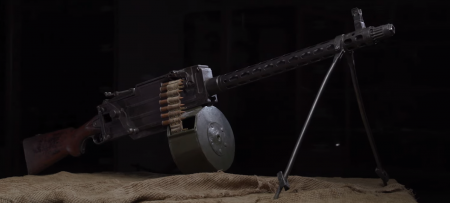
The freshly minted Soviet Red Army initially tried to follow the German path by creating Maxim-Tokarev, a light version of the Maxim machine gun, similar to the German LMGs of World War I. However, the first batches drew a lot of criticism from the troops. Despite the fact that some of those could be attributed to the initial production difficulties, normal when developing a new weapon, the Red Army deemed the Maxim-Tokarev had “little potential”. It was heavy (not a great trait for a light machine gun) and complex. All further improvements led to the loss of resemblance to the original Maxim and consequently made the production even more complex. The situation called for designing a new light machine gun from scratch.
At the time, Soviets had great relationships with Weimar Republic and considered the German light machine guns very promising. Ten samples were purchased, including some tank-mounted models. While we cannot know exactly, these were presumably the MG-13 experimental versions.
However, before long the Red Army command had a new domestic option. The Degtyarev DP-27 was designed by Vasily Degtyarev, a disciple of General Vladimir Fedorov of “Fedorev Avtomat” fame. After creating several prototypes, the designers settled on the time-tested gas blowback scheme.
Choosing the feed system was not nearly as straightforward. The shape and rim of the Russian standard 7.62x54R cartridge made it unsuitable for either box-feeding or belt-feeding. The British .303 and the old French 8x50R Lebel rifle cartridges had the same problem. Fedorov tried to convince the leadership to adopt the Japanese 6.5x50mmSR Arisaka cartridge but to no avail. In the end, the Command decided on sticking to the good old 7.62x54R. Designing a reliable box magazine for it seemed nigh impossible, and cloth ammo belts had their own share of problems in the wet and cold of Russia (Soviets would not be able to produce metallic belts until WWII). So Degtyarev opted for a pan magazine, which not only could reliably feed 7.62x54R cartridges but also contained 47 rounds, way more than standard 20- or 30-round box magazines of competing light machine guns.
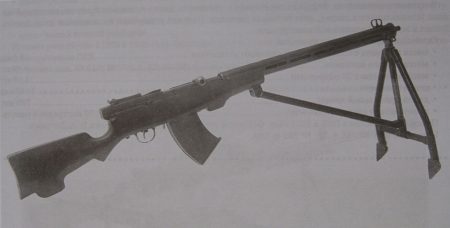
On the other hand, the pan-feed system also had many flaws. The Army testers noted excessive “dead weight” (too much metal per cartridge). Pans were also complex and expensive to manufacture. In combat, sharing ammo between soldiers and reloading under fire were also far from simple. Even before World War II, the Red Army worked hard on designing a reliable alternative to pan-feeding DP-27, testing a variety of approaches from installing modular belt feeders and top-mounted box magazines to copying Japanese clip-fed systems off models captured during Khalkhin Gol battles in 1939.
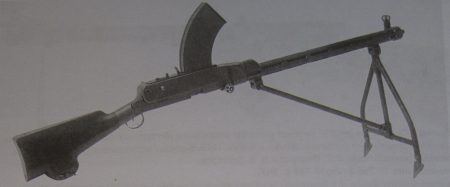
At some point, Goryunov-Voronkov-Goryunov (yes, two different Goryunovs) model was developed. It was a belt-fed light machine gun and it was ready for testing even before the war but it never went into production and its design later contributed to SG-43, Russia’s most successful HMG of WWII.
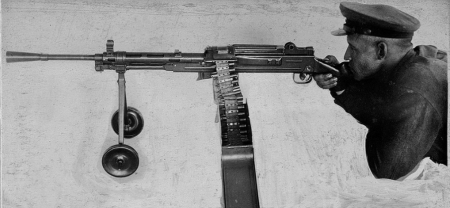
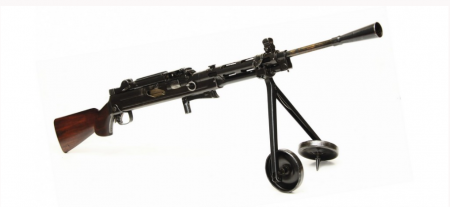
After June 22, 1941, a steady flow of soldier complaints about the DP began from the frontlines. Most of them regarded the pan-related issues but some were new. The military complained about the carbon buildup in the gas system and recoil springs that often failed due to overheating as they were mounted directly under the air-cooled barrel. In 1942, the USSR held a competition for a new light machine gun. Simonov’s RPS LMG won and a small batch was produced but it never went into mass production. In 1943, Kalashnikov’s light machine gun was tested at the shooting range but failed to reliably feed the 7.62x54R from a high-capacity bottom-mounted box magazine. Definitely an ‘I told you so’ moment for Degtyarev.
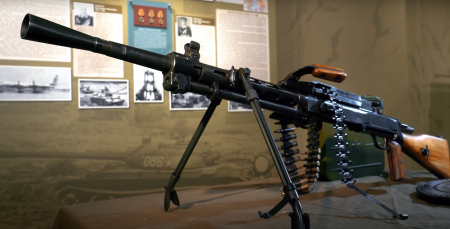
As a result, no new light machine gun chambered for a rifle cartridge was ever adopted. The DP was modernized as DPM, with a more comfortable pistol grip, new bipods and a recoil spring moved to a cooler location at the back of the barrel. It even received a belt feed mechanism, which could be installed instead of a standard pan, and was relabeled as RP-46 machine gun. However, as the country stepped into the era of intermediate cartridges, LMGs chambering rifle cartridges became a thing of the past and Degtyarev moved on to design RPD-44, one Russia’s most known LMGs around the world.


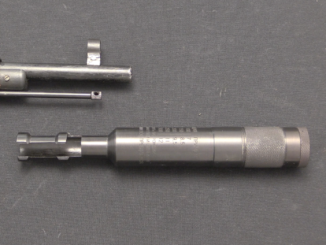
“(…)At the time, Soviets had great relationships with Weimar Republic and considered the German light machine guns very promising. Ten samples were purchased, including some tank-mounted models. While we cannot know exactly, these were presumably the MG-13 experimental versions.(…)”
Is that gun shown here
https://www.kalashnikov.ru/po-sheme-drejze/
or it was different one?
yes, this is the same story
Honest question, what is with the wheels? I can kinda see that it might make it easier to switch targets, but would make it less stable and send more recoil to the shooter and move the sights more. What exactly was the thinking
Reminds me of Keyser Soze’s crippled walk.
Are they “wheels”? Or round plates with spiked feet that can also be used in a “hasty” or more flexible way? If so, not the worst idea ever.
I think those wheels are meant both for towing the gun (in something like the fashion of the shielded carriages of heavier Soviet MGs) and to flip down to become spiked foot pads when deployed (along the lines of what some early BAR bipods had, though others had more of a “sled” profile). I would think there’d be definite issues with that “flipping” interfering with actually using the wheels for towing, and with the spikes picking up grass and debris while doing so. That’s probably why they didn’t catch on and remain unfamiliar to us today.
It was an experimental prototype. “Wheels” could serve as a support or help move the machine gun a short distance. But too difficult for mass production.
Perhaps an idea to keep spiked bipod feet from sinking into snow?
Excellent addition to the history of USSR machine guns in the english language.
“…SG-43, Russia’s most successful HMG of WWII…”(C)
I heard that much more succeeded in this…
Germans in South Africa.
Although I think that the similarity is rather formal, I have not had the opportunity to study SS77 personally.
He was “the best” only in Russia and only in comparison with Degtyarev’s.
The Soviet Goryunov’s were a very mediocre machine gun after modernization in 1943.
Before that, it was just crap.
And even earlier, before the major overhaul in 1942, they did not work at all.
Actually, therefore, the release of Maxims continued until the very end of the war. Likewise with the duets Nagant-TT33 and PPSh-PPS.
The only decent Soviet machine gun is the PK, a prototype of which was captured in Germany.
“Goryunov” could not be modernized in 43. It appeared in 42 and in 43 its mass production was launched.
2. The USSR could not capture any “prototype of the PG”. The most difficult part of any Soviet machine gun is the rimmed cartridge feed system. The Germans, in principle, did nothing like this for their Mauser cartridges.
““Goryunov” could not be modernized in 43.”(С)
OK.
And what is called “design changes to improve technical and user characteristics”?
They even look different. And constructively, not to mention the many technological improvements.
Regarding Goryunov’s feeding system, I don’t see anything unique. Extractor from Maxim (Vickers) and reducer from Browning 1917.
Although Browning has made it all simpler and more reliable.
By the way, it was the feeding system that created the most serious problems in the 1942 model (and earlier in the prototype).
Dismantling of bullets, deformation and explosions of cartridges were largely overcome in 1943, but not completely.
For example, cartridges with a brass body and heavy bullets, not everyone can work normally in it.
And the explosions of cartridges come back when using too sensitive primers.
And about the Hungarian, nothing really is known. Most likely (since it has a similar device) the problems are the same.
And (if we’re already talking about feeding) here.
Doesn’t it look like anything?
https://ru.files.fm/u/nrz2f49zw
As Germany was the first nation to adopt a rimless infantry cartridge, I find it extremely difficult to believe that any prototype machine gun for a rimmed infantry cartridge should have existed in Germany in WW2 to be “captured” by the Soviets.
Do you have any supporting evidence for your claim?
“(…)Soviet Goryunov’s were a very mediocre machine gun after modernization in 1943.”
If it was such poor performer as you wish how do you explain than Hungarians developed and produced KGK https://modernfirearms.net/en/machineguns/hungary-machineguns/kgk-eng/
which did not differed action-wise?
Mr Ulanov, thank you for the excellent exposition and for fielding replies from the internet, a mostly thankless proposition. I have heard before the question in the US Army, why don’t we just make the Russian PK in .308? True admiration from the opposition.
As far as I knew, in Poland they made a PK chambered for 7.62×51 NATO. It does not need a two-stage feed, but the Kalashnikov system ensures smooth and reliable feed from the tape. The kinematics of the movement of the cartridge when feeding is a very interesting topic. The Degtyarev heavy machine gun (DS-39) had problems with her. 🙁
“(…)Poland they made a PK chambered for 7.62×51 NATO”
Yes, its’ name is UKM-2000 description in English http://www.sadefensejournal.com/wp/ukm-2000-the-polish-successor-to-the-pkm/
There is also another version for that cartridge, Bulgarian 7.62×51 mm ARSENAL Machine Gun MG-M2 https://www.arsenal-bg.com/c/machine-guns-26/762×51-mm-mg-m2-56
it does use M13 type metal links
Nice! Finally an article on Forgotten Weapons again instead of a video! not that I dislike them, but I miss the publication of new informative articles on here. Thank you Mr. Ulanov. 🙂
One question I have is: in the last paragraph you call the RPD-44 “Russia’s most known light machine gun”. Well, for one it is from the USSR and two isn’t it the only light machine gun in 7,62*39 mm introduced into service by the soviet army? The RPK is not really a machine gun. Being a sturdier AK basically. So the RPD is the only one actually and by default the most famous one.
Yes, of course, from the USSR. :)))
Formally, the PKK is a Kalashnikov light machine gun. 🙂 I am planning to make a separate article about the RPD-44. It will also explain why the PKK was chosen further.
“So the RPD is the only one actually and by default the most famous one.”
————————-
It looks that way and even that one was pulled out of service. Oh wait… we have Minimi, right? 🙂
Seriously, as it became obvious out of long discussions on this page by some senior members (Mr. Kirk in particular comes to mind) it looks as a logical conclusion the “light machinegun” is outdated concept. It cannot handle full-size rifle round and it is not effective with reduced-power one it that role.
Now, how about Minimi, is it not on its way out too? With the U.S. Marines it is.
Also the UK? Or am I mistaken?
Withdrawn from infantry use. Although it was the Minimi Para, not the “full size” Minimi. Took our lot about 15 years to work out that the Minimi Para wasn’t an ideal longer-range proposition…
As I gather the major vice of Minimi, part of its weight, is excessive fire dispersion. This problem was studied by U.S. and Canadian militaries without solution.
The UKvz.59 was a universal machinegun (it is in letters U=universalni, K=kulomet) with two different configurations distinguished primarily by different barrels and optional tripod.
There was a 7.62×51 version for export, but I believe in was not fielded in post Iron curtain period. They bought limited number of FN Mk48 instead. As I gather they are not very happy with new one either.
“Now, how about Minimi, is it not on its way out too? With the U.S. Marines it is.”
Keep calm, Fabrique Nationale apparently detected that machine gun firing full-power cartridge which is not as heavy as ancient L7A1 machine gun is in demand, so they crafted EVOLYS https://modernfirearms.net/en/machineguns/belgium-machineguns/fn-evolys-2/
What is EVOLYS acronym for?
Yes it is on its way out, at least with Marines. The Army has ordered recently a new lot.
The new weapon you are showing has not been known to me at this point. It seem to eschewed the original welded steel-sheet receiver and replaced it with more modern cast aluminum housing. Same approach is evident with SIG and some other Russian and Chinese designs. The FN has no choice but to present new solutions, or they would become irrelevant.
They just continue to “prepare for the last war.” 😉
The only justification for the existence of such freaks as MINIMI can only be the same feeding system as rifles.
In the case of MINIMI it does NOT WORK.
And the very idea of an MG under the STG ammunition is just as vicious as the STG under the MG cartridge.
Considering the cost of ammunition for the tasks performed by modern LMGs, it seems much more rational to use light grenade launchers of 25-30 mm caliber for this purpose.
It looks like an attempt to build a space shuttle from scrap metal from a landfill.
Outwardly, it certainly looks like, but…